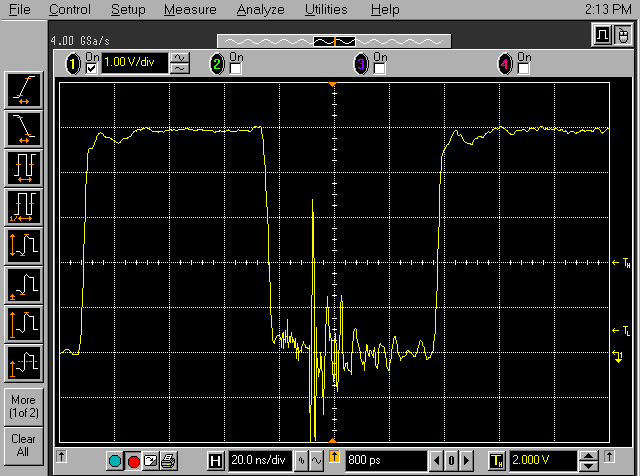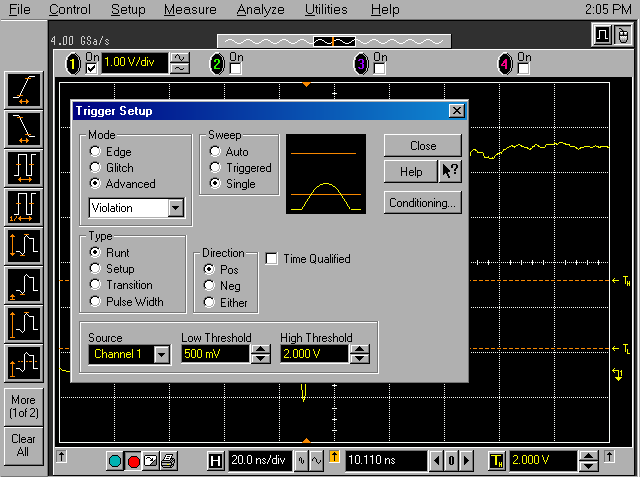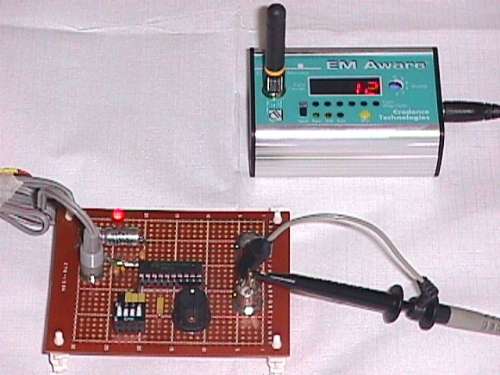The Elusive Glitch

Figure 1. The Elusive Glitch

Address: P. O. Box 1457, Los Gatos,
CA 95031
TEL:
800-323-3956/408-356-4186
FAX:
408-358-3799
Mobile: 408-858-4528
URL:
www.dsmith.org
Email: doug@dsmith.org

Figure 1. The Elusive Glitch
So you think you have found the glitch that has been causing your system to "hang-up", reset, or otherwise not perform as expected......Now what? Often a glitch, such as shown in Figure 1 above, occurs infrequently, possibly once in tens or hundreds of thousands or more clock cycles. The result may be a malfunction that happens once in an hour or day. So when we finally catch a glitch, it is cause for celebration. Our hunt for the problem is over, or is it?
Figure 2 shows the scope setting that caught the glitch in Figure 1. Known as "runt" pulse triggering, the scope triggers on a glitch that exceeds one threshold but not another higher one. This feature has been in scopes for some years now and makes it possible to see an infrequent glitch in a repeating waveform such as a clock. But just catching a glitch does not mean it is really in the circuit, between the nodes being measured. A great deal of engineering time can be wasted trying to track down the source of a glitch that does not really exist in the circuit.

Figure 2. Scope Setup to Capture Glitch
Last month's Technical Tidbit, , Improving FET Probe Immunity to Unwanted Noise Pickup, discussed the sensitivity of an FET probe to respond to a signal different from the one being measured. The same mechanism, sensitivity to voltage across the ground lead, makes all single ended probes potentially sensitive to EMI, electromagnetic interference, in the environment of the measurement. The glitch in Figure 1 was generated by the device described in the June 2001 Technical Tidbit, A Static Field Powered EMI Source from a distance of about 1.5 meters and represents impulses that are very common in the environment.
One way to alarm a potentially false glitch is shown in Figure 3. Placing
an ESD event detector near the measurement will let you know when a transient
has happened in the neighborhood of your measurement. If the detector
alarms at the same time the scope catches a glitch, the measurement might
not be an accurate representation of the signal in the circuit and should
be checked. One way to check for externally induced glitches is to short
the probe to its ground lead while the ground lead is connected to the
circuit ground. The result should be zero, if not, the result is the externally
induced error in the measurement. Even logic signals can produce errors
of a few volts and ESD events in the same room can produce errors much
larger.

Figure 3. Setup to Detect External EMI Caused Scope Glitches
The Technical Tidbit for November, 2001 will describe a more accurate way to qualify glitches as valid or the result of external EMI.
For more information see:
More detailed information about this and other topics on this website is available from this site's new subscription service (to start this Fall) and seminars.